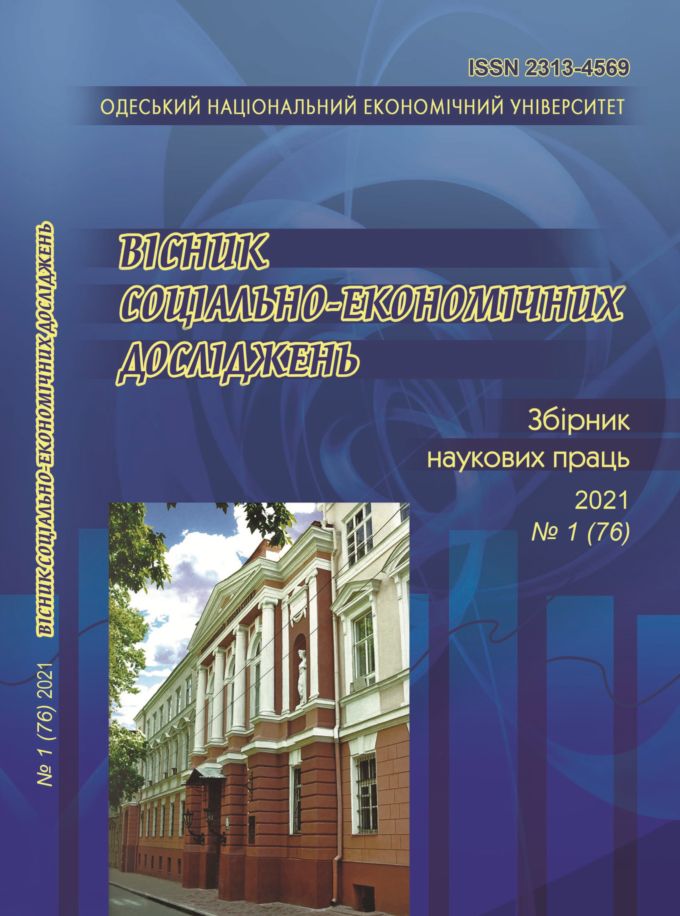ІНДЕКСНИЙ МЕТОД У СУЧАСНИХ ДОСЛІДЖЕННЯХ ГРОШОВОГО ОБІГУ УКРАЇНИ
DOI:
https://doi.org/10.33987/vsed.1(76).2021.100-112Ключові слова:
індекси, фактори-співмножники, результативний показник, ланцюгові підстановки, ізольований вплив факторів, абсолютний приріст, ВВП, грошова маса, швидкість оборотуАнотація
У статті розглянуто теоретичні та практичні питання застосування індексного методу під час проведення статистичного моніторингу грошового обігу. Визначено сутність та основні концепції грошового обігу України. З’ясовано, що грошові потоки та кількість грошей в економічній системі є найважливішим регулятором матеріального виробництва та всіх економічних процесів, що дозволило побудувати та охарактеризувати двох- та трьохфакторні детерміновані моделі ВВП за 2019‒2020 роки. З цією метою розраховано такі показники грошового обігу, як середньорічний розмір грошової маси, готівки, частки готівки у грошовій масі, швидкість обороту грошової маси та швидкість готівки. Наведено та реалізовано алгоритми оцінювання впливу означених показників на абсолютну зміну ВВП України індексними методами ланцюгових підстановок та ізольованого впливу факторів. Виявлені переваги та недоліки наведених методів як з точки зору статистичних розрахунків, так і з точки зору економічних концепцій грошового обігу. Позитивний вплив на динаміку ВВП країни у 2020 році здійснює саме зростання грошової маси, а показники швидкості зменшують зростання ВВП. Показано доцільність використання індексного методу виявлення ізольованого впливу факторів на розкладання абсолютного приросту ВВП України. Цей же метод дозволив дослідити, як розподіляється ефект взаємодії швидкості обороту грошової маси та її обсягів залежно від їх відокремленого впливу. При такому підході кожному фактору надаються однакові умову розрахунку, результати не залежать від економічної природи показників та порядку їх розташування у вихідній моделі ВВП, відсутні протиріччя між економічним постулатам грошового обігу, хоча проблеми вибору методу дослідження та його обґрунтування досі залишаються відкритими
Посилання
Zakhoroshko, S. S. (2018). Theory and methodology of economic indices [Teoriya i metodologiya ekonomicheskih indeksov], GGAU, Grodno, 270 s. [in Russian]
Yankovyi, O. G. (2012). Deterministic models of factor economic analysis. Methodology of statistical support of the region development [Determinovani modeli faktornoho ekonomichnoho analizu. Metodolohiia statystychnoho zabezpechennia rozvytku rehionu: Monohrafiia], Atlant, Odesa, s. 125–142 [in Ukrainian]
Andriienko, V. Yu. (2004). Statistical indices in economic research [Statystychni indeksy v ekonomichnykh doslidzhenniakh], Akdemperiodyka, Kyiv, 118 s. [in Ukrainian]
Holubova, H. V. (2019). Application of index models in the assessment of foreign economic activity [Zastosuvannia indeksnykh modelei v otsiniuvanni zovnishnoekonomichnoi diialnosti], Statystyka Ukrainy, No.1, s. 24–34, DOI: 10.31767/su.1(84)2019.01.03. Retrieved from: http://nbuv.gov.ua/UJRN/su_2019_1_5 [in Ukrainian]
Zadorozhna, R. P. (2008). Evolution of the index method of analysis [Evoliutsiia indeksnoho metodu analizu], Ekonomichni nauky «Statystyka Ukrainy», No. 4 (43), s. 80–85. Retrieved from: http://194.44.12.92:8080/jspui/handle/123456789/548 [in Ukrainian]
Savras, I. Z. (2016). Current problems and possibilities of application of statistical methods in public administration [Aktualni problemy ta mozhlyvosti zastosuvannia statystychnykh metodiv u derzhavnomu upravlinni], Efektyvnist derzhavnoho upravlinnia, Vyp. 1-2 (2), s. 24–31. Retrieved from: http://www.lvivacademy.com/vidavnitstvo_1/edu_46/fail/ch2/5.pdf [in Ukrainian]
Pshyk, B. I. (2017). Ensuring the stability of money circulation in Ukraine in the context of the implementation of monetary policy instruments [Zabezpechennia stiikosti hroshovoho obihu v Ukraini v konteksti realizatsii instrumentiv hroshovo-kredytnoi polityky], Visnyk Universytetu bankivskoi spravy, No. 1, s. 15–20. Retrieved from: https://journals.indexcopernicus.com/api/file/viewByFileId/223905.pdf [in Ukrainian]
Brychka, B. B. (2020). Monetary policy in ensuring the stability of the national currency: Author’s thesis [Hroshovo-kredytna polityka u zabezpechenni stabilnosti natsionalnoi hroshovoi odynytsi: avtoreferat dys. … kand. ekon. nauk], Lviv, 20 s. Retrieved from: https://lnu.edu.ua/wp-content/uploads/2020/08/aref_brychka.pdf [in Ukrainian]
Chornyi, V. S. (2017). Features of using the index method in the study of prices and tariffs [Osoblyvosti vykorystannia indeksnoho metodu pry doslidzhenni tsin i taryfiv], Ekonomichnyi analiz, T. 2, s. 74–78. Retrieved from: https://www.econa.org.ua/index.php/econa/article/view/1350/1105 [in Ukrainian]
Voitolovskii, N. V., Kalinina, A. P., Mazurova, I. I. (2019). Economic analysis: in two parts. P. 1 [Ekonomicheskiy analiz. V 2-kh ch. Ch.1 ], 7-e izd., Yurayt, Moskva, 291 s. [in Russian]
State Statistics Service of Ukraine: website [Derzhavna sluzhba statystyky Ukrainy: sait]. Retrieved from: http//www/ukrstat.gov.ua [in Ukrainian]
National Bank of Ukraine: website [Natsionalnyi bank Ukrainy: sait]. Retrieved from: https://bank.gov.ua/ua/statistic [in Ukrainian]
##submission.downloads##
Опубліковано
Номер
Розділ
Ліцензія
Авторське право (c) 2021 Вісник соціально-економічних досліджень

Ця робота ліцензується відповідно до Creative Commons Attribution 4.0 International License.






